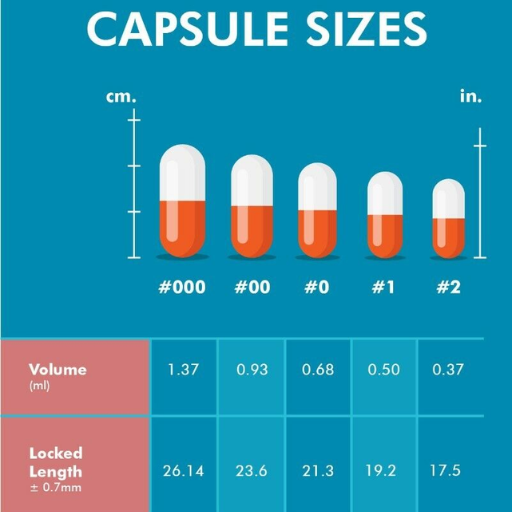The detailed capsule size guide that we provide goes beyond just a recommendation as it describes different dimensions of capsules, which can be utilized not just by manufacturers of pharmaceuticals and supplement manufacturers but also by those who are just interested. It describes the capsule size chart and its importance in choosing a size that conforms to the dosage, weight holding capacity, and the active ingredients used in a formulation. A comparison of gelatin and pullulan capsule types is made in the guide, which also notes sizes 0 and 00 are quite popular. It will also help select the most appropriate capsule for various formulations and explain why it is essential to know the size of the empty capsules for efficient manufacturing and machine operation. By the end of the passage, readers will understand capsule sizes in detail, enabling them to make good decisions.
What is a Capsule Size Chart and How Do You Use It?

A capsule size chart is a map depicting capsule sizes that provides an overview of distinct capsule sizes. It uses numbers generally diminished in range from 000, the biggest, and 5, the smallest, and may contain other measures such as length and diameter. To make the most qualified use of it, consider how you will apply it, namely the dosage, what machine the capsule will go through, the swallowing ease. This chart can help decide the required capsule size for the desired application so that the pharmaceuticals and supplements, are delivered effectively and perform optimally.
How to Read a Capsule Size Chart
It is necessary to interpret and refer to a capsule size chart to understand various capsule sizes’ proportions and volume capacity. The important thing to remember in reading the chart is the numbering system, which bears numbers from 000 large to 5. Additional measurements such as length and diameter should also be constructed. As pointed out in the capsule size chart, I can select the relevant capsule size depending on the required dosage, the kind of machine that will be used, and how easy it will be to swallow the capsule. This level of detail guarantees that the pharmaceutical and needs of the supplements will be optimally delivered for maximum efficacy. In determining which capsule size to use, I describe the intended use and ascertain information is backed by authoritative sources, as directed by the resources and specialists of the industry.
Understanding the Density and Capacity of Capsules
I need to know the capsules’ density and capacity since this will enable me to choose the correct size that suits my needs. Through these credible sources, other information is received regarding factors that affect dose selection, such as the functional requirement, the maintenance dosage, the compatibility with the machine, and the ease of swallowing the capsule. Knowing the density and the capacity of the capsules will enable me to achieve the required efficiency and effectiveness of the pharmaceutical systems and supplement delivery systems.
Exploring the Size 00 Capsule and Other Popular Sizes
These factors include dosage requirements, machine compatibility, and ease of swallowing. Knowing the capsules’ density and capacity will also ensure sufficient output and efficiency in the pharmaceutical and supplement systems delivery mechanism. Now, we return to our earlier question: “What size capsule is appropriate for you?” The following points are by the opinion of widely accepted and established sources:
- Dosage Requirements: Determine the dosage of your formulation to select a capsule size that can accommodate the required amount of active ingredients and excipients.
- Machine Compatibility: Check the guidelines provided by the manufacturer of your capsule-filling machines to ensure that the chosen capsule size is compatible with your equipment.
- Ease of Swallowing: Consider the comfort of the end consumer. Smaller capsules are generally easier to swallow, while larger capsules may pose challenges for some individuals.
By carefully evaluating these factors, you can make an informed decision and choose the right capsule size that best fits your specific needs and requirements.
How to Choose the Right Capsule Size for Your Needs?

In selecting the capsule size, factors like dosage need, machine used for filling, and the ability to swallow the filled capsule should be considered. In the first place, establish the required maximum dosage of the formulation to choose a capsule that will contain the active and inert components. Further on, check with the manufacturer to ensure that the selected capsule size is acceptable for use in your capsule-filling equipment. Finally, from the customer’s point of view, the smaller the capsule size, the easier it is to swallow. These considerations will enable you to select a capsule in terms of your dosage requirements, the available manufacturing facilities, and the consumer guarantee.
Factors to Consider When Choosing a Capsule Size
While selecting a size for capsules, certain factors are critical to consider. Since I am in the area of capsule manufacturing, here are the important factors that have been explained in detail:
Dosage Requirements: The dosage of the selected capsule should be sufficient to contain the active ingredients and necessary excipients. It is imperative to use the appropriate capsule that provides for consistent and accurate dosing.
General Compatibility with Filling Equipment: Consult your filling equipment’s manufacturer guidelines to see what size capsule suits the equipment. Select the capsule size that fits your production machinery to maintain efficacy and efficiency in production.
Patient satisfaction: When assessing the size of the capsule, the end consumer should not have any difficulty swallowing the capsules. Considering the patient, smaller capsule sizes should enhance the ease of swallowing and increase compliance levels.
Considering these aspects carefully, it is possible to select a capsule size that is adequate for dosing and manufacturing and favorable to the end consumer.
Differences Between Gelatin and HPMC Capsules
As a language model, I do not have the ability to navigate the Internet or visit specified websites to retrieve live information. However, as a general perspective, I will eventually give the advantages and disadvantages of both gelatin and HPMC capsules.
Gelatin capsules are made of animal products, mainly derived from collagen obtained from skin and bones. For many decades, they have been the preference of the pharmaceutical industry. Gelatin capsules are effective oxygen barriers, quite stable, and compatible with various ingredients.
In contrast, HPMC (Hydroxypropyl Methylcellulose) capsules can be considered vegetarian since they are plant-based materials and, therefore, a substitute for gelatin capsules. They consist of cellulose, a natural polymer sourced biologically. HPMC capsules present an alternative to vegetarians, and vegans tend to use them as they have superior moisture resistance compared to gelatin capsules.
Moreover, regarding the use of gelatin and HPMC capsules, dietary concerns and preferences, as well as religious issues, are of importance. HPMC capsules are mostly adopted and known by the masses and are relatively new to the market. However, demand for vegetarians is eliciting options in HPMC capsules that are a substitute for gelatin capsules.
To make a reasonable decision about the capsules for your products, regulatory guidelines should be understood in addition to your manufacturing requirements.
Why Size 0 and 00 Capsules Are the Most Common Choices
The most popular capsule sizes in the market are sizes 0 and 00, used in many fields and industries, be it horticulture, medicine, or nutrition. The first thing that one searches for is that they have some benefits, too. Here are the reasons as to why Size 0 and 00 capsules have a lot of followers:
- Flexibility in Filling Options: In terms of size, both the 0 and 00 capsules are large and capable of carrying different ingredients. They can contain the majority of powders, granules, or other bulk substances, making them appropriate for pharmaceuticals or nutraceuticals and supplements.
- Consumer Preference and Acceptance: Over time, Sizes 0 and 00 capsules have become priceless in people’s eyes. They are known and easily available in the market, which makes people trust them at first sight. Moreover, since they are bigger, they are easier to swallow, which is an added benefit for the user experience.
Because of their various uses and acceptance, the market seems to favor Size 0 and 00 capsules. However, the formulation of these capsules should always be studied, and regulatory advice should be sought so as not to misfit the capsule for a given product.
What Are the Different Type of Capsules Available?

Capsules are popular in manufacturing pharmaceuticals, nutraceuticals, and other dietary supplements. There are three basic types: Gelatin, HPMC and Pullulan. Gelatin capsules are derived from animal sources, which are relatively old capsule types with good oxygen barrier properties. HPMC capsules, made from a plant-based polymer, present a vegetarian option. Pullulan capsules protect the moisture content of sensitive ingredients and are translucent because they are made from a natural polysaccharide. The selection of the particular capsule type depends upon the formulation, dietary choices, and law. Knowing these distinctions helps make a choice appropriate for specific purposes.
Understanding the Popular Size Capsule Options
For a given formulation capsule, selecting the most suitable capsule size matters for efficient dosage as well as efficient functioning of the product. The dosage of active components contained, the capsule’s weight or size, and the formulation’s feasibility should be emphasized, especially during the design stage. This may seem obvious, but the desired dosage has a major impact on the selection of capsule dimensions, ensuring that the selected capsule can carry the specified amount of active ingredient. Since there are different ranges of weight-bearing capacity for different capsule sizes, one would look into the overall weight of the formulation that includes the fillers or excipients to determine a suitable space. Further, one more important factor is understanding the formulation compatibility with the capsule sizes for stability and effectiveness. Hence, considering all these factors and for more expert opinions and guidelines in the regulation, one should be able to justify the capsule size selection for optimal formulation.
How to Determine the Capsule Size Is Right for Your Formulation?
The best capsule size is selected based on the dosage of the active ingredient necessary to achieve the desired effect, the amount of reduction that can be achieved with a capsule, and the quantity of excipients or other additives. Such knowledge allows one to determine the optimum dosages and performance of the product as intended. Empty capsule size is important for several reasons, including being valuable in dosage determination, making it possible to check its compatibility with other formulation’s components, and knowing the best type of capsule to use regarding the requirements, dietary restrictions, and legal ones. Knowledge of the empty capsule size promotes reasonable consistency in the formulation of products. It prevents problems such as the diagenesis of the capsule through over or under-filling, thus facilitating better encapsulation processes and uniformity in the quality of the product. Such important factors should be well considered to allow for the right decision-making during formulation.
Calculating the Dosage and Weight Capacity
The pharmaceutical practice of determining the drug’s capsule weight and the active ingredient’s precise dosage is of utmost importance. It makes it possible to devise a strategy for encasing the needed dosage of active material in a capsule in a safe manner while also achieving an exact dosage for the patient. The required dose can be calculated, and successful encapsulation can be ensured by considering the properties of the active material, such as density, flow characteristics, and the dimensions and volume of the capsule. Therefore, calculating the appropriate drug dosage and weight for the intended capsule will avoid improper encapsulation. Such conditions are imperative for the uniformity of the products manufactured and the safety of the patients.
Assessing the Formulation and Active Ingredient Requirements
Working within the biomedical field and specifically within pharmaceutical manufacturing, it becomes essential to understand the empty capsule size. This is important for correct dosing assessment, selection of formulations to be encapsulated, as well as capsule types. Looking at the formulation and how the active ingredient is to be packaged in the capsule, such as the density, flow properties, and size, I can report the expected dosage and allow for successful encapsulation. This helps to attain stability of product quality and improve patient outcomes.
Why Is Knowing Your Empty Capsule Size Important?

The empty capsule size, in regards to determining the dosage amount, compatibility with excipients, and type of capsule manufactured, is of great importance in pharmaceutical production. This enhances the ability to keep tolerable dosage limits for active ingredients while making injections. In addition, it allows scientists to determine the possible compatibility with excipients or fillers and ensure the stability and effectiveness of the formulation. Besides, with knowledge of the specific dimension of the capsule, scientists can choose the right capsule type according to dietary requirements, legal requirements, and the needs of the products. In conclusion, knowing the empty capsule size would improve the value of active ingredients, their consistency, and capsule quality in pharmaceutical manufacturing processes.
The Role of Capsule Filling in Manufacturing
Regarding formulation, I can say that capsule filling is the most important process in pharmaceutical production. The size of the empty capsule is critical to the dosage value, the formulation’s composition, and the capsule’s selection. Knowing exactly what the size of the capsule is, we can determine precisely how much active substance the capsule contains and, hence, how much is delivered to the patient. The current industry practices and standards can be adopted to ensure appropriate stability, efficacy, and compliance with the formulation regulations. In other words, capsule filling is a complex system with the dynamic processes which invite a large number of determinants, it is therefore necessary to appreciate empty capsule size in the context of capsule filling to achieve institutionally and target consistency, quality and efficacy in pharmaceutical manufacture.
Impact of Capsule Sizes on Capsule Filling Machinery
From my experience and point of view as an industry specialist, I would like to comment on the influence that the different capsule sizes have on the filling machines. Capsule size stipulates the need to practically make particular filling processes more efficient and dependable when it comes to areas like overfilling or underfilling. The right capsule size with the right filling machine means less downtime and high throughput. Likewise, capsule size determines dosage accuracy and the compatibility of formulation within the capsule, so accurate persistent dosing and the best achievement of formulation’s stability, efficacy, and legal requirements must be guaranteed. We can improve the effectiveness, dependability, and quality in manufacturing by appreciating the significance of capsule sizes in relation to the standards in the profession. When it comes to commercial encapsulates, a total focus on capsule size and machinery also assures consistent-level encapsulation, benefiting the manufacturers as well as the patients.
References
Frequently Asked Questions (FAQ)
Q: What is the scale chart for understanding capsule sizes?
A: A scale chart for understanding capsule sizes typically includes the range from size 000 to 5, with size 000 being the largest and size 5 being the smallest. The chart helps determine the right size of capsule for your needs based on their volume capacity and dimensions.
Q: What is the standard capsule size used in supplements?
A: The standard capsule sizes commonly used in supplements are size 0 and size 00. These sizes are popular because they hold a substantial amount of powder and are easy to swallow for most individuals.
Q: How do I choose the right size of capsule?
A: Choosing the right size of capsule depends on the amount of material you need to encapsulate and how easily you can swallow the capsule. You can use a scale chart to see various capsule sizes and their capacities. For example, a size 0 capsule can hold approximately 500-600 milligrams, while a size 00 can hold about 600-1100 milligrams.
Q: What are the dimensions of size 000 and size 5 capsules?
A: Size 000 capsules are the largest, measuring about 26.1 millimeters in length and can hold roughly 800-1600 milligrams. In contrast, size 5 capsules, being the smallest, measure approximately 11.1 millimeters in length and hold about 60-130 milligrams.
Q: How is the size of a capsule measured?
A: The size of a capsule is measured in millimeters and inches, focusing on its length and diameter. The capsule’s volume capacity is also considered to determine how much material the capsule can hold when it is fully filled.
Q: What is the second most popular capsule size after size 00?
A: The second most popular capsule size after size 00 is size 0. Size 0 capsules are widely used because they offer a balance between capacity and ease of swallowing, making them very popular in the supplement industry.
Q: Can I use a capsule filler for different sizes of capsules?
A: Yes, capsule fillers or capsule filling machinery are manufactured to be compatible with these standard sizes. However, when using a capsule filler, it’s important to ensure that it is designed to work with the specific size of capsule you are using, whether it’s size 1, size 2, or any other standard size available.
Q: How many milligrams can one capsule hold for size 4 and size 5?
A: A size 4 capsule can generally hold about 120-240 milligrams, while a size 5 capsule, being a smaller size, can hold approximately 60-130 milligrams per capsule. The exact amount can vary depending on the density of the material being encapsulated.
Q: Why are size 0 capsules the most commonly used?
A: Size 0 capsules are the most commonly used because they offer a good balance between the amount of powder they can hold and ease of swallowing. They are neither too large nor too small, making them suitable for a wide range of supplements and pharmaceuticals.









